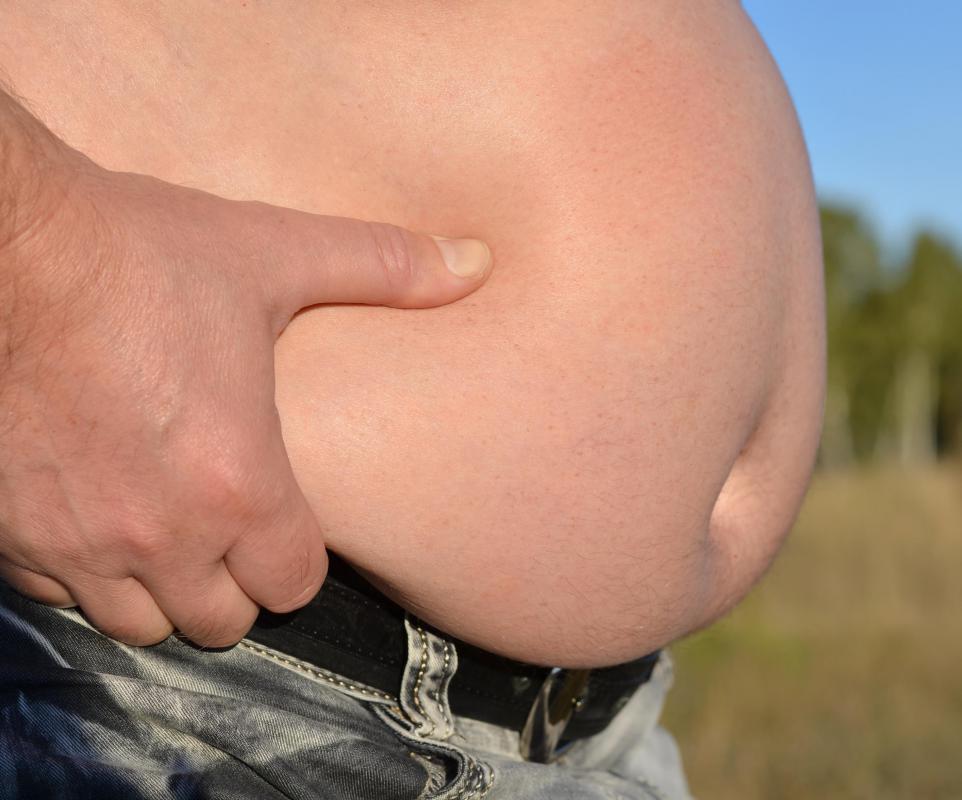At TheHealthBoard, we're committed to delivering accurate, trustworthy information. Our expert-authored content is rigorously fact-checked and sourced from credible authorities. Discover how we uphold the highest standards in providing you with reliable knowledge.
What is the Greater Omentum?
The greater omentum is a peritoneal fold, meaning a fold in the lining of the abdominal cavity, that hangs over the stomach like an apron. It extends to the colon and is suspended from the stomach to cover most of the small and large intestine. Sometimes called the caul or velum, its main functions are to prevent adhesions along the peritoneal surfaces, to limit the spread of infection in the peritoneal cavity, and to store fat.
The omentum prevents adhesions by producing an oily substance that covers its surface. This substance allows the slippery tissue to constantly move around in the abdominal cavity. When an organ is inflamed, however, the omentum will create an adhesion that walls off the inflamed organ, thereby protecting the rest of the abdomen from potential infection.

Fat storage is perhaps the best known function of the greater omentum. There are three types of fat: fat in the blood, which is referred to as triglycerides; subcutaneous fat, which is the fat under the skin; and omentum fat. This fold stores fat that is easy for the liver to access, so excess fat in this location can cause bad cholesterol and triglyceride levels to go up. In addition, it can use insulin meant for other purposes, so blood sugar levels can rise as well.

The fat of the greater omentum lies under the muscles of the belly and hugs all the organs in the vicinity of the stomach. One of the reasons that reducing the amount of fat in the belly can have quick positive effects on health is that it relieves the strain on the organs that are compressed by it. This is the fat that presents as the dreaded "beer belly." Not only does excess fat in the omentum lead to inflammation of the liver, arteries and immune system, it also replicates itself. To reduce the fat in the area, one should follow a healthy diet, make time for plenty of exercise, and reduce stress, which increases appetite and slows metabolism.
AS FEATURED ON:
AS FEATURED ON:















Discussion Comments
Do animals also have this protective fold? If so, then I have seen fat accumulated on a greater omentum in a cat that is just ridiculous.
My friend puts her cat's food in a feeder that continuously distributes it. So, the cat just eats all day long while her owner is away at work.
She looks like a white basketball. What's funny is that her head and paws are normal size! She has so much belly bulk that I worry about her health.
I would have thought that more fat around your organs would mean more cushioning, so they would be better protected. I didn't know that it could actually cause them harm. I need to lose some weight!
@healthy4life – I think it's a different kind of stress that causes you to build greater omentum fat. I was in a state of prolonged stress at my last job that I carried around with me every day for six years, even when I was at home on the weekends.
This wasn't the kind of intense stress that makes you unable to eat. This was a state of being constantly under pressure and irritated.
It actually made me eat more, because I am a stress eater. When stress intensifies, I reach for a bag of potato chips or candy, and I don't stop eating until I get satisfied.
This kind of behavior led to me putting on so much belly weight that I couldn't button any of my pants. It is super hard to lose weight around your greater omentum, especially when you are in your thirties.
I think it's strange that stress can lead to storing more fat in this area. I know that when I'm really stressed out, I can't eat much at all without feeling nauseated. It's as if my body is rejecting any nourishment because it is in such distress.
@pastanaga - Unfortunately, it's largely genetic whether or not you're going to put on weight around this area. Men are more likely to than women, but I think that's just because women are supposed to have a higher body fat percentage anyway and it needs to be distributed properly.
People think they can get a flat stomach through situps and crunches alone and, while that definitely helps with definition, it's not going to make your stomach flat if you have too much body fat. That requires cardio exercise, but even then, some people just have to accept that they are more prone than others to putting on weight here.
I think this is one of the reasons that women who have small waists are considered attractive, even if they have larger than normal hips or thighs. Putting weight on around this area is really bad for your health and I've heard it basically leads to a heart attack eventually. And no wonder if the heart is having to strain against fat which is crushing the internal organs.
This is why people want to have a flat stomach. It's the ultimate sign that you've got a healthy greater omentum, whether you're a man or a woman.
Post your comments